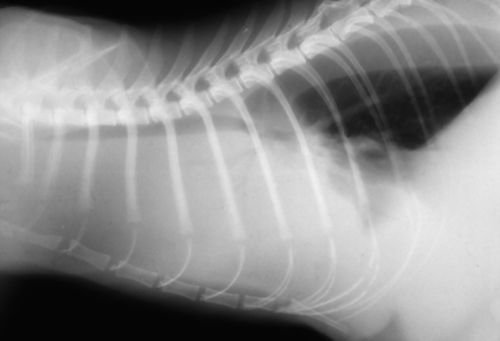Feline Medicine Q&A 12
| This question was provided by Manson Publishing as part of the OVAL Project. See more Feline Medicine questions |
The lateral thoracic radiograph is from a 9-year-old neutered female DSH cat that presented with progressive inspiratory dyspnoea over a 3-month period.
| Question | Answer | Article | |
| What radiographic features can be seen and what are the major differential diagnoses? | The lateral radiograph shows a large soft-tissue density in the cranial thorax. This is causing marked dorsal displacement of the trachea, caudal displacement of the carina, and is obscuring the cranial lung fields. There is evidence of a pleural effusion and the cardiac silhouette is obscured. The radiographic appearance is consistent with a large cranial mediastinal mass. The major differential diagnoses are anterior mediastinal lymphoma or thymoma (benign epithelial tumour). Other possibilities include extension/metastatic/ectopic thyroid adenocarcinoma, a mediastinal abscess, or a branchial cyst. |
Link to Article | |
| What findings would be expected on clinical examination of this cat? | Clinical examination would show reduced ‘rib-spring’ or compliance of the cranial thorax, an absence of lung sounds cranially, and dullness on percussion of the thorax cranially. There would also be caudal displacement of the normal cardiac sounds. |
Link to Article | |
| How readily could you distinguish between the two major differential diagnoses in this case? How would you do this? | Differentiating malignant lymphoma from thymoma is not always easy. Cytological examination of fine needle aspirates from the mass (or cytology of pleural fluid if present) can sometimes be diagnostic. Lymphomas often have large numbers of lymphoblasts and lymphocytes with evidence of malignancy, whereas thymomas may reveal atypical or neoplastic epithelial cells. However, atypical epithelial cells are not always present in aspirates from thymomas, and the predominant cell type is usually small lymphocytes. Some thymomas contain a very large proportion of lymphocytes (lymphocytic thymomas), and as some lymphomas are well differentiated lymphocytic forms, distinguishing these two tumours can be problematic. Even needle biopsies do not always give a definitive diagnosis and, where doubt exists, surgical biopsies may be required. |
Link to Article | |
